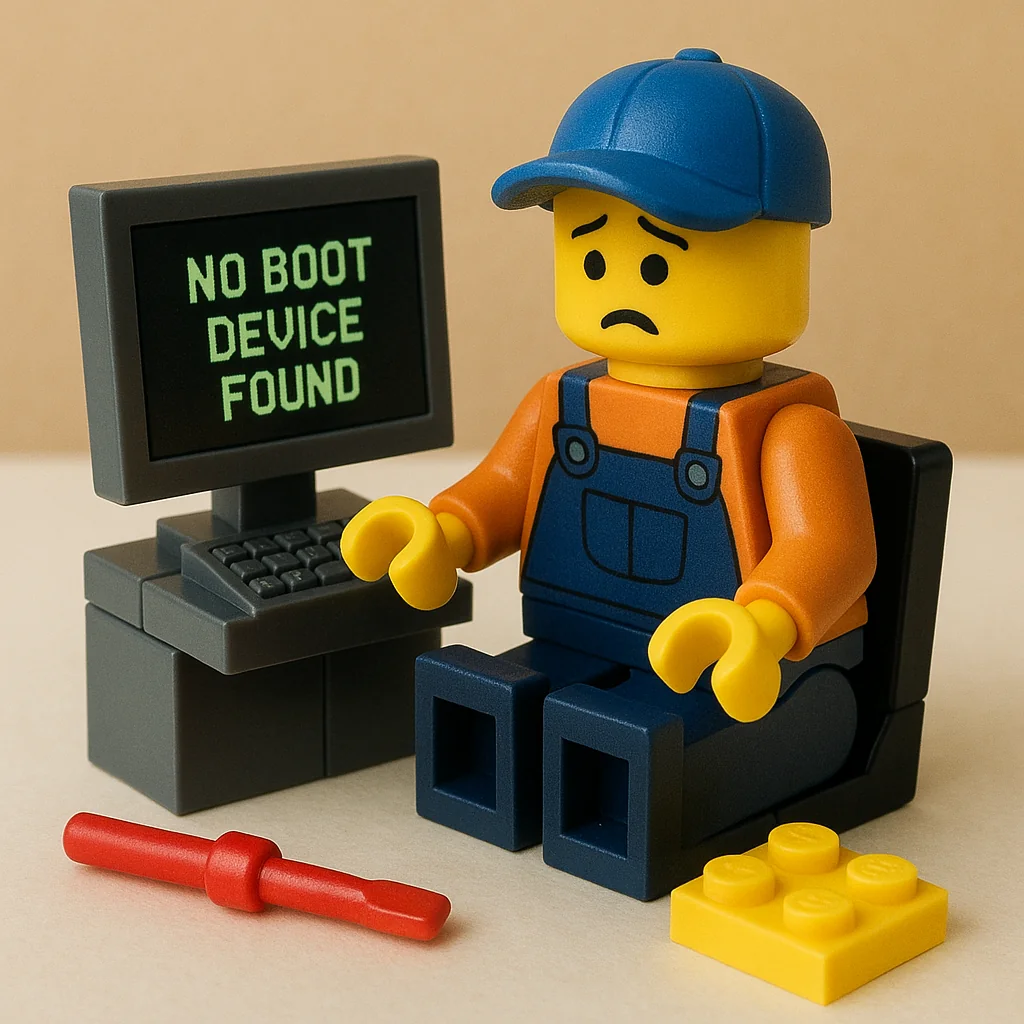Why does my computer say ‘No boot device found’?

Table of Contents
What to look at:
- SATA/NVMe drive failing or cable loose.
- Boot mode mismatch (UEFI vs Legacy) after a reset.
- Boot order changed; the OS drive fell behind USB/DVD.
- Damaged bootloader; needs repair via recovery media.
- Recent clone to SSD missing EFI partition.
Need help? Check here: /services/repairs/
What it might be (likely causes)#
Storage not detected or failing
A loose SATA cable, unseated NVMe, or a dying drive can disappear from firmware. If the drive isn’t listed in BIOS/UEFI, the OS can’t boot. If it is listed but throws the error, suspect the bootloader/partitioning.Boot mode mismatch (UEFI vs Legacy/CSM)
Windows installed in UEFI/GPT won’t boot in Legacy/MBR mode and vice versa. A CMOS reset can flip this setting. Background: UEFI, MBR vs GPTBoot order drift
After firmware updates or adding drives, the boot order may rank a USB stick or empty device first. Set the OS drive (or “Windows Boot Manager”) back to the top. If you need brand keys and boot-UI tips: /posts/boot-from-usb-every-major-system/Broken bootloader
Power loss or disk issues can corrupt the bootloader. Windows repair tools (bootrec,bcdboot) can rebuild it. Reference: Microsoft bootrec/bcdbootImperfect clone/migration
A clone that skipped the EFI System Partition (ESP) or marked partitions wrong will boot to this error. Verify the ESP exists and is flagged correctly. Migration prep tips: /posts/prepare-for-computer-repair/ and backups: /posts/simple-data-backups-without-cloud/
Things to check (quick, safe wins)#
See if the drive exists in firmware
Enter BIOS/UEFI (F2,Del,F10vary by brand). If the drive isn’t listed, reseat cables (SATA data + power) or the NVMe stick. If still absent, the drive may be failing.Confirm boot mode matches the install
- If Windows was installed as UEFI, ensure UEFI mode is enabled and CSM/Legacy is disabled.
- If it was Legacy/MBR, enable Legacy/CSM (temporary) to boot and plan a proper migration later. General boot thinking: /posts/the-art-of-making-things-boot/
Fix boot order
Put Windows Boot Manager (for UEFI) or the correct drive (Legacy) at the top. Remove USB/DVD from first place while testing.Run a quick drive health check
If firmware sees the drive, boot a Windows installer or recovery USB → Repair your computer → Command Prompt and run:chkdsk C: /scanAny ugly errors? Back up first if possible.
Repair the bootloader (Windows)
From recovery Command Prompt (UEFI install):bootrec /scanos bootrec /fixmbr bootrec /fixboot bootrec /rebuildbcd bcdboot C:\Windows /l en-us /s S: /f UEFINote: Replace
S:with your EFI partition letter (assign one withdiskpartif needed). Microsoft reference: Repair the boot menuVerify the EFI System Partition exists
Usediskpart→list vol. Look for a small (~100–300 MB) FAT32 partition (ESP). If missing after a clone, recreate/copy it, then rerunbcdboot.If the drive is failing, stop and back up
SMART warnings or missing drives that reappear intermittently point to imminent failure. Image the disk to a healthy SSD before more experiments: /posts/simple-data-backups-without-cloud/
Patterns that narrow it down#
- Drive not in BIOS/UEFI at all → physical connection or failed drive.
- Drive present, “Windows Boot Manager” missing → bootloader/ESP issue.
- Error appeared after CMOS reset → UEFI/Legacy mode mismatch or boot order.
- After cloning to SSD → missing/incorrect ESP or wrong partition flags.
If you’re considering a sturdier, low-drama setup after recovery, a Linux conversion can be a clean slate on older PCs: /posts/linux-distros/ and local EOL context: /posts/windows-10-end-linux-kirksville/
When to pause and get hands-on help#
- The drive vanishes intermittently or SMART attributes are worsening.
- Bootloader repairs loop or error out, or
bcdbootcan’t find Windows. - You need to salvage files before fixing boot.
Bench testing with spare cables, cloning tools, and a controlled recovery environment will save your data and time.
Insight#
“No boot device” isn’t a verdict—it’s a map. Either the device isn’t there (power/cable/drive), the firmware can’t hand off correctly (mode/order), or the loader is missing. Solve it in that order: see the drive, match the mode, rebuild the loader. If storage is suspect, protect data first; computers are replaceable, your files aren’t.
Need a precise recovery, clone, or boot repair in Kirksville?
See /services/repairs/.